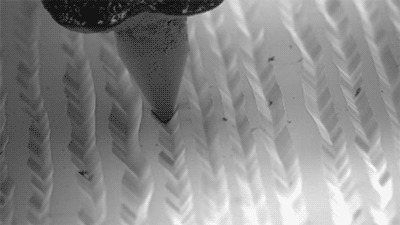Science-is-magical - Science Is Magic

More Posts from Science-is-magical and Others

My tummy is blushing now.
People Were Asked: ‘What’s The Coolest Thing Most People Don’t Know About Their Own Body?’

An international team of researchers has finally decoded the science behind a plant responsible for no small degree of human misery: poison ivy.
For the first time, we now know why poison ivy leaves – the bane of campers, hikers, and overly curious kids alike – make us itch, and the answer lies in a key molecule called CD1a, which scientists have long known about but didn’t fully understand until now.
“For over 35 years we have known CD1a is abundant in the skin,” says researcher Jerome Le Nours from Monash University in Australia. “Its role in inflammatory skin disorders has been difficult to investigate and until now has been really unclear.”
One of the reasons for that lack of clarity has been that many experiments on skin disorders involve animal testing – specifically lab mice. And mice don’t produce CD1a, effectively creating a kind of ‘blind spot’ in the studies up to this point.
To get around this and examine whether CD1a might play a part in how human skin reacts when we brush up against poison ivy (Toxicodendron radicans) and similar rash-inducing plants, the researchers genetically engineered mice that did produce the molecule.
In doing so, the team found that CD1a – a protein that plays an important role in our immune systems – triggers a skin-based allergic reaction when we come into contact with urushiol, the allergen that functions as the active ingredient in plants like poison ivy, poison oak, and poison sumac.
When urushiol interacts with skin cells called Langerhans cells, the CD1a proteins (which are expressed by Langerhans cells) activate the immune system’s T cells. In turn, the T cells produce two proteins – interleukin 17 and interleukin 22 – which cause inflammation and itchiness.
Continue Reading.

Trees ‘talk’ by exchanging chemicals. They communicate through underground fungi, and when they can recognize their relatives, they share nutrients. Basically, tree 'families’ help each other out. Source

Scalp is the soft tissue layer covering the bony vault over the brain. It is usually described as having five layers: S: The skin on the head from which head hair grows. It contains numerous sabaeceous glands and hair follicles C: Connective tissue. A thin layer of fat and fibrous tissue lies beneath the skin. A: The aponeurosis called epicranial aponeurosis (or galea aponeurotica) is the next layer. It is a tough layer of dense fibrous tissue which runs from the frontalis muscle anteriorly to the occipitalis posteriorly. L: The loose areolar connective tissue layer provides an easy plane of separation between the upper three layers and the pericranium. P: The pericranium is the periosteum of the skull bones and provides nutrition to the bone and the capacity for repair.
(x)

Have you ever seen a Lybia crab? Often called boxer crabs, or pom-pom crabs, these tiny crustaceans are easily identified by a unique behavior: they hold anemones on their claws to defend themselves from predators, keeping the anemones small enough to wield by limiting their food intake. But how do they get the anemones in the first place? Researchers think they have an answer: by stealing one from another crab, and then splitting it in half to create two identical clones—one for each claw.
Two graduate students, Yisrael Schnytzer and Yaniv Giman, set out to discover how the Lybia crabs acquire their anemones. They spent years observing and collecting crabs (Lybia leptochelis, specifically) from the Red Sea. Given that Lybia crabs are exceptionally well-camouflaged and only a few centimeters across, this was no easy task, but they managed to observe or collect more than 100 individuals.
Every specimen Schnytzer and Giman found was in possession of a pair of anemones, and each anemone belonged to the genus Alicia. Interestingly, the anemones themselves were not found living by themselves; they were only found already living on the claws of Lybia crabs. The researchers decided to study some of the crabs in a laboratory, to see if more observation would solve the mystery of how they acquired their anemones to begin with.
In the lab, the researchers conducted several experiments, the first of which was to take one anemone away from a crab. When left with just one anemone, the crab solved the problem by splitting the remaining anemone into two. The two halves of the anemone would then regenerate into two identical clones, one for each claw, over the course of several days.
The second experiment involved removing both anemones from one crab and placing it in a tank with a crab that still had both its anemones. The result: the two crabs would fight, with the anemone-less crab usually succeeding in stealing one anemone from the other crab. These fights did not tend to result in injuries to the crabs themselves, and once each crab was in possession of one anemone, both crabs would split their anemone into halves to create a pair of clones.
In addition to these experiments, Schnytzer and Giman examined the genes of the anemones found on the wild crabs. Every crab collected from the wild was holding a pair of identical clones. This might mean that anemone theft is rampant among Lybia crabs in the Red Sea, and that it might be the main way that these crabs acquire their anemones.
At any rate, it is clear that the crabs are frequently splitting anemones in two, inducing asexual reproduction in another species and potentially limiting that species’ genetic diversity in the process—a rarity outside the human world.
Based on materials provided by PeerJ and ScienceDaily
Journal reference: Yisrael Schnytzer, Yaniv Giman, Ilan Karplus, Yair Achituv. Boxer crabs induce asexual reproduction of their associated sea anemones by splitting and intraspecific theft. PeerJ, 2017; 5: e2954 DOI: 10.7717/peerj.2954
Image credit: Yisrael Schnytzer
Submitted by volk-morya
-
 seismic-tartness liked this · 2 months ago
seismic-tartness liked this · 2 months ago -
 geminispasswordjournal liked this · 5 months ago
geminispasswordjournal liked this · 5 months ago -
 amutsuri liked this · 6 months ago
amutsuri liked this · 6 months ago -
 k9ok reblogged this · 6 months ago
k9ok reblogged this · 6 months ago -
 k9ok liked this · 6 months ago
k9ok liked this · 6 months ago -
 boozledorf liked this · 6 months ago
boozledorf liked this · 6 months ago -
 unsureprincess reblogged this · 6 months ago
unsureprincess reblogged this · 6 months ago -
 miniatureduckwizard liked this · 7 months ago
miniatureduckwizard liked this · 7 months ago -
 ghost-with-anxiety reblogged this · 11 months ago
ghost-with-anxiety reblogged this · 11 months ago -
 mysstical-siren reblogged this · 1 year ago
mysstical-siren reblogged this · 1 year ago -
 akaleiloveshumor reblogged this · 1 year ago
akaleiloveshumor reblogged this · 1 year ago -
 saphicspacesociety20 reblogged this · 1 year ago
saphicspacesociety20 reblogged this · 1 year ago -
 tmitissy reblogged this · 1 year ago
tmitissy reblogged this · 1 year ago -
 gold-empire liked this · 1 year ago
gold-empire liked this · 1 year ago -
 twaktoe reblogged this · 1 year ago
twaktoe reblogged this · 1 year ago -
 twaktoe liked this · 1 year ago
twaktoe liked this · 1 year ago -
 foxxxyana liked this · 1 year ago
foxxxyana liked this · 1 year ago -
 puppbun liked this · 1 year ago
puppbun liked this · 1 year ago -
 okwhotookmyusername reblogged this · 1 year ago
okwhotookmyusername reblogged this · 1 year ago -
 oakwizard reblogged this · 1 year ago
oakwizard reblogged this · 1 year ago -
 not-thinking-clearly reblogged this · 1 year ago
not-thinking-clearly reblogged this · 1 year ago -
 magicmagica reblogged this · 1 year ago
magicmagica reblogged this · 1 year ago -
 the-b-spot reblogged this · 1 year ago
the-b-spot reblogged this · 1 year ago -
 spain reblogged this · 1 year ago
spain reblogged this · 1 year ago -
 gold-rajang liked this · 1 year ago
gold-rajang liked this · 1 year ago -
 gold-rajang reblogged this · 1 year ago
gold-rajang reblogged this · 1 year ago -
 pepleosupremacy liked this · 1 year ago
pepleosupremacy liked this · 1 year ago -
 dulharpa liked this · 1 year ago
dulharpa liked this · 1 year ago -
 riverrabbits reblogged this · 1 year ago
riverrabbits reblogged this · 1 year ago -
 riverrabbits liked this · 1 year ago
riverrabbits liked this · 1 year ago -
 spider-xan liked this · 1 year ago
spider-xan liked this · 1 year ago -
 ekanatsume liked this · 1 year ago
ekanatsume liked this · 1 year ago -
 zoe-porphyrogenete reblogged this · 1 year ago
zoe-porphyrogenete reblogged this · 1 year ago -
 zoe-porphyrogenete liked this · 1 year ago
zoe-porphyrogenete liked this · 1 year ago -
 itsc liked this · 1 year ago
itsc liked this · 1 year ago -
 kukuandkookie reblogged this · 1 year ago
kukuandkookie reblogged this · 1 year ago -
 apocryphaladagium reblogged this · 1 year ago
apocryphaladagium reblogged this · 1 year ago -
 nattvingen liked this · 1 year ago
nattvingen liked this · 1 year ago -
 sinclair-solutions reblogged this · 1 year ago
sinclair-solutions reblogged this · 1 year ago -
 andromeda-or-andromache-maybe reblogged this · 1 year ago
andromeda-or-andromache-maybe reblogged this · 1 year ago -
 candy-sweetener reblogged this · 1 year ago
candy-sweetener reblogged this · 1 year ago -
 candy-sweetener liked this · 1 year ago
candy-sweetener liked this · 1 year ago -
 dreamycastaway reblogged this · 1 year ago
dreamycastaway reblogged this · 1 year ago -
 liapmetinlwatmi liked this · 1 year ago
liapmetinlwatmi liked this · 1 year ago -
 iwillhaveamoonbase liked this · 1 year ago
iwillhaveamoonbase liked this · 1 year ago -
 lucidnonsense reblogged this · 1 year ago
lucidnonsense reblogged this · 1 year ago











